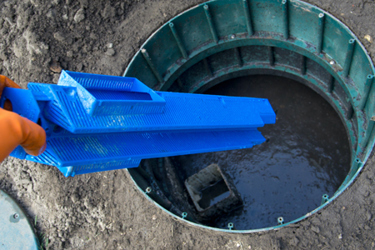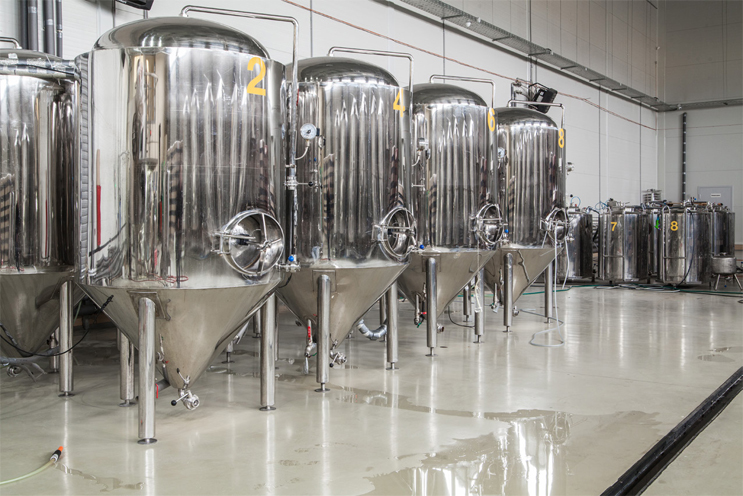Roundup On High-Strength Wastewater: Treatment Challenges And Solutions
By Stephanie Beadle

Wastewater is by nature a nuisance, but there are especially difficult varieties, covered herein, that can cripple onsite systems if not understood and handled properly.
High-strength wastewater is commonly overlooked when implementing onsite or decentralized wastewater treatment. Many wastewater sources are viewed as similar to residential sources and lumped into the “domestic strength” waste category, only to find that there is much higher than anticipated organic loading and insufficient pretreatment prior to discharge.
While the definition of high-strength waste (HSW) varies among agencies and publications, the consensus is that wastewater is high strength when biochemical oxygen demand (BOD); total suspended solids (TSS); fats, oils, and greases (FOGs); and nitrogen are higher than typical domestic wastewater. Typically, high-strength wastewater results from industrial or commercial sources. These sources are often variable, with fluctuating concentrations and higher potential for co-contaminants that may impact treatment effectiveness.
Common HSW Sources
Some of the most common HSW sources are convenience stores, food establishments (anything with a commercial kitchen), wineries and breweries, campgrounds and RV parks, hospitals, nursing homes, and laundromats. Another potential source of HSW can occur when the organic loading of a typical domestic-strength wastewater source deviates from standard assumptions. These can include septic tank operational issues and a reduction in dilution with the use of low-flow water fixtures.
HSW Treatment Design Challenges
While there are a variety of high-strength wastewater sources, there is one step that should come first when designing for any of them: characterization of the influent waste stream. It should be made clear that a single sample will most likely not be representative of the fluctuations in mass loading that commonly occur with HSW sources. When possible, it is helpful to have multiple samples to better characterize variability in the waste stream. It is important to characterize both organic loading in the form of BOD/TSS, but also co-contaminants that may interfere with BOD/TSS treatment. The following are common constituents and conditions that may be encountered when dealing with HSW.
Fats, Oils, and Grease
FOGs often go hand-in-hand with sources of HSW. The most common source of fats are animal fats from cooking and associated cleanup. Fats are typically the most sensitive to temperature when compared to oils and greases but are more easily treated via biological processes. Oils are most commonly vegetable-based cooking oils or soaps and remain in liquid form within the typical temperature range of wastewater. Biological treatment processes are less effective for oils when compared to fats. Lastly, greases in wastewater are petroleum-based and are frequently a result of beauty and cleaning products such as lotions, detergents, and hair products entering the system.
The most effective pretreatment technology for FOGs are grease interceptors immediately following wastewater collection. The grease trap is highly effective on fats, as they are more easily solidified and separated from the waste stream via a grease trap. An effluent filter on the grease trap can further address FOGs; however, it can lead to increased maintenance and inconvenience if the FOG concentration is such that the filter fouls quickly and requires frequent replacement. In some more severe cases, the best option is to separate the FOGs at the source and haul them offsite to be treated separately.
Temperature
While warmer wastewater is preferable to promote biological processes (ideally between 77° and 95°F), some commercial applications may introduce hot wastewater (most commonly those with high-heat dishwashers or washing machines). For HSW sources with higher effluent temperatures (above 80°F), it may be beneficial to utilize either a holding tank prior to a grease interceptor or a larger volume grease interceptor in the design to add residence time to promote cooling and mixing with cooler wastewater introduced between washing cycles. This will help promote fat solidification within the grease interceptor prior to the septic tank.
Alkalinity and pH
Cleaning products and food waste can impact pH in HSW. Wastewater with a pH outside of the preferred range (6–9) can prohibit biological activity. Heavy use of cleaning products containing bleach can raise the pH outside of the ideal treatment range. Conversely, food service locations like coffee shops or wineries can contribute wastewater below the ideal treatment range. In addition to inhibition of biological treatment, lower pH can also make phosphorus precipitate more soluble and may increase total phosphorus in system effluent. While dilution and flow equalization can provide some buffering for spikes or drops in pH, the best way to combat wastewater pH outside of the preferred operational range is to incorporate pH adjustment into pretreatment via chemical feed.
Cleaning products and food residues can contain bicarbonates and carbonates, which can directly reduce alkalinity in wastewater. Alkalinity directly impacts the nitrification/denitrification process. Treatment systems with effluent nitrogen limits may require alkalinity adjustment via chemical feed to maximize total nitrogen reduction within the treatment system.

Wastewater from breweries contains brewing and fermentation byproducts. Breweries are designed with drains throughout the facility to catch rinse water from every stage of the brewing process.
Flow Rate
Fluctuations in flow rate can easily impact the mass loading rate into a treatment system. Almost all sources of wastewater have variability in flow throughout the day, but in HSW sources in particular, operational cycles can greatly impact wastewater flow rate and mass loading. Providing a flow equalization (EQ) tank along with timed dosing to better control treatment system loading and control potential spikes in both flow and BOD concentrations is the best way to manage these fluctuations. Flow EQ tanks must provide sufficient volume to handle peak flow rates, and flow EQ pumps also need to be sized to provide a preferred average flow to dose the treatment system.
Quaternary Ammonia
Commonly found in disinfectants, surfactants, dryer sheets, and fabric softeners, quaternary ammonium compounds (QACs) are found in both domestic and high-strength wastewater. Many QACs are prolific and can have a biocidal effect throughout the wastewater treatment system. Anaerobic conditions like those found in a septic tank provide poor biodegradation; however, aerobic conditions do increase biodegradability of QACs. QACs can be especially biocidal to nitrifying bacteria and should be monitored closely for treatment systems requiring nitrification. The best way to mitigate QACs is to eliminate them at the source or limit use and increase tankage to allow dilution within the system.
BOD/TSS/Nitrogen
Once co-contaminants and wastewater quality that may impact biological treatment have been addressed, the primary contaminants can be more easily treated. Following a grease trap and septic tank, BOD and TSS are reduced, but the bulk of the BOD/TSS reduction for HSW applications will occur under aerobic conditions. The biological treatment system should be sized to accommodate the average mass loading and should also be able to handle surges in mass loading that may occur. HSW treatment systems typically require larger footprints and higher airflow for aerobic treatment. Some systems incorporate recirculation of partially treated wastewater to reduce the overall system footprint. Common biological treatment system technologies used include biofilm media-based options like moving bed bioreactors or fixed bed bioreactors, as well as a variety of activated sludge processes.
While the flow EQ tank will prevent flow surges into the biological treatment system, there may still be operational variability at the source that could increase BOD/TSS or nitrogen concentrations entering the treatment system. BOD/TSS addressed with aerobic treatment and nitrogen will require both aerobic and anoxic phases to address total nitrogen in system effluent.
Importance Of System Start-Up, Maintenance, And Monitoring
It is especially important to use treatment system start-up as an opportunity to further characterize the waste stream and to ensure that sufficient treatment occurs before system effluent is released. All monitoring equipment should be tested to prevent reading errors once the system is operational.
Depending on state requirements and the complexity of the wastewater treatment system, a licensed operator may be required. With or without a licensed operator, a regular operation and maintenance schedule is crucial for system upkeep when dealing with HSW. Regular monitoring and system adjustments can prevent potential contaminant breakthroughs and identify necessary treatment system adjustments that may be required if the HSW source has changed significantly.
Understanding The Wastewater Source
The biggest mistake when selecting pretreatment technologies for onsite wastewater treatment is to make general assumptions about the wastewater quality. Many HSW sources come as a surprise after a system has already been designed and installed due to lack of characterization. As with almost any design application, the more data available, the more appropriate and accommodating the final product will be.
Conclusion
Wastewater engineers are increasingly faced with complex HSW challenges. Careful consideration at the start of the design phase of the inputs to the system in design, flow rate fluctuations based on usage, how the system will be operated, maintained, and monitored, and any potential need for pretreatment will result in a HSW treatment system design that will provide efficient and effective treatment for the long haul.
About The Author
 Stephanie Beadle, PE, is a wastewater engineer with Infiltrator Water Technologies. She is a professional engineer with 10 years of environmental remediation and process engineering experience. She joined Infiltrator’s technical services team in 2022. Stephanie holds a B.S. in environmental engineering from Johns Hopkins University and an M.S. in environmental science and engineering from the Colorado School of Mines. Stephanie is a process design engineer for Infiltrator’s advanced wastewater treatment products, including the ECOPOD and ENVIRO-AIRE product lines. Stephanie can be reached at sbeadle@infiltratorwater.com.
Stephanie Beadle, PE, is a wastewater engineer with Infiltrator Water Technologies. She is a professional engineer with 10 years of environmental remediation and process engineering experience. She joined Infiltrator’s technical services team in 2022. Stephanie holds a B.S. in environmental engineering from Johns Hopkins University and an M.S. in environmental science and engineering from the Colorado School of Mines. Stephanie is a process design engineer for Infiltrator’s advanced wastewater treatment products, including the ECOPOD and ENVIRO-AIRE product lines. Stephanie can be reached at sbeadle@infiltratorwater.com.
